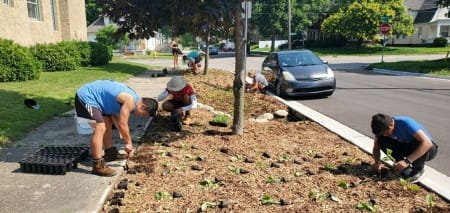GSI Story: Grand Rapids Rain Gardens
Grand Rapids rain gardens take off in popularity following demonstration project
Blogpost originally published by the Department of Environment, Great Lakes, and Energy (EGLE)
The sandy soils in urban Southeast Grand Rapids are ideal for soaking in stormwater and keeping most of it out of Plaster Creek, which flows from agricultural areas through commercial zones, and residential neighborhoods to the Grand River, Michigan’s largest waterway.
Unfortunately, many of these water loving soils have become covered with impermeable surfaces and the stormwater is piped to the creek along with many non-point source (NPS) pollutants.
In 2015, Plaster Creek Stewards (PCS) planted 10 demonstration curb cut rain gardens in the Grand Rapids neighborhood of Alger Heights to show residents how stormwater could be captured and treated in their own front yards.
The project was funded with Section 319 Clean Water Act funding through EGLE’s NPS program. Within this walker-friendly community, the gardens became a talking point, and requests for new gardens began pouring in.
Typically, 75% of garden requests are not able to be fulfilled due to constraints caused by topography, trees, or buried utilities. However, to date PCS has installed over 120 gardens in partnership with EGLE’s NPS program, the City of Grand Rapids, the U.S. Environmental Protection Agency (EPA) Great Lakes Restoration Initiative, and of course, the residents themselves.
These gardens are engineered, shaped and mulched, and then planted with local genotype native plants to maximize the infiltration of water as well as the biodiversity of plants in the neighborhoods. Plaster Creek Stewards collects seeds, propagates the native plants in their greenhouses, and uses the plants in restoration projects like the curb-cut rain gardens which then offer more seed for future projects. Calvin University students conduct research and help install and maintain green infrastructure under the guidance of PCS staff year-round. Besides adding biodiversity and diminishing stormwater runoff in these urban neighborhoods, PCS is helping to train the next generation of environmental heroes.
PCS has learned a lot over the past seven years. They studied which native plants survive and perform best in these novel habitats and quantified which plants transpire the most water. Over time they are developing a list of curb-cut rain garden all-star plants that are effective at removing stormwater and pollutants but also short enough to not block important lines of sight for motorists and pedestrians. PCS added sediment traps to the garden entryways to capture sediment coming off the street after witnessing the significant quantity of dirt covering garden basins the first year. Communication with the homeowners has grown over the years as well. PCS came to realize that learning how to care for a garden requires more than one conversation and a garden map. Now these residents are able to tune in to encouraging emails, Facebook posts, garden visits, and workshops. PCS has benefitted from their ongoing relationship with the City of Grand Rapids, together working to identify the best sites for future gardens, ensure proper permitting, and navigate how to handle garden restorations after roadwork or utility line replacements
There is a lot that happens behind the scenes to have a project like this succeed. But the successful outcome is that residents who live in neighborhoods with curb-cut rain gardens are seeing more bees and butterflies and less stormwater being transported down the storm drains to Plaster Creek.
More information on EGLE-funded rain garden and other nonpoint source projects is available on the Nonpoint Source Project website.
Caption: The Plaster Creek Stewards plant a demonstration curb-cut rain garden in a Grand Rapids neighborhood.

